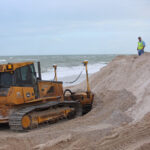VERO BEACH – Indian River County has missed out on a $6 million cost-sharing grant from the state for the Sector 3 north beach restoration project, and is unlikely to ever see the hoped-for funds.
The next beach replenishment project under consideration is Sector 5 from Tracking Station south to the City of Vero Beach.
While this current round of beach renourishment is fully funded through proceeds from various taxes and grants, the lack of state funds places further sand replenishment in future years in jeopardy.
“I think Sector 5 is pretty close to impossible,” said Michael Ochsner, the Town of Indian River Shores appointee to the beach preservation committee. “The fact is that there is not going to be any money coming from anywhere.”
The county applied for the state funding when it was told it had qualified for consideration.
However, officials have been left to compete for a dwindling supply of cash against other beach projects around the state.
“I think it will be an uphill battle because the state doesn’t seem to have a lot of extra money right now,” said Indian River County Budget Director Jason Brown.
The state money for beach restoration cost-sharing was allotted through documentary stamp revenues from real estate transactions, but with declining revenues, the state has been holding back on the cash it had allotted for the program.
“Originally (the state) had a dedicated funding source, based on document stamps of $30 million going into the Florida beaches program,” said County Coastal Engineer James Gray. “However, due to the downturn, that pool of money is becoming smaller and smaller and they are unable to fund as many projects.”
Commissioner Peter O’Bryan, who serves as the liaison for the Beach & Shore Preservation Advisory Committee, said the county recognized last year it would likely be footing the bill for the project outside of the money from the Sebastian Inlet Taxing District.
“We knew a year ago that the state had very little money available for beach projects and that in the state ranking system, ones that had federal funds to go along with them would be given a higher priority,” he said.
The state ranks funding for beach restoration projects on a 100-point scale and the county received 29 points for the Sector 3 restoration.
County staff has requested a review from the state, claiming the project was undercounted on the basis of expected project performance and use of innovative technology – namely employing upland sand rather than offshore dredging.
The state currently has allocated just $6.8 million of the funds for all qualified beach projects.
“According to James Gray at the last meeting, in order for our project with our points rating to get anything, the pool would have to be about $40 million,” said Ochsner.
Gray pointed out that the county has up to three years after the project is completed to apply for the funds and remains hopeful that their ranking will improve in the meantime.
Brown said at one point in the budgeting process, the county was estimating construction costs of $17.4 million for using dredged sand, and the county could have faced a budget gap if the state money had not come in.
The construction costs came in considerably lower, in the $7 to $8 million range.






